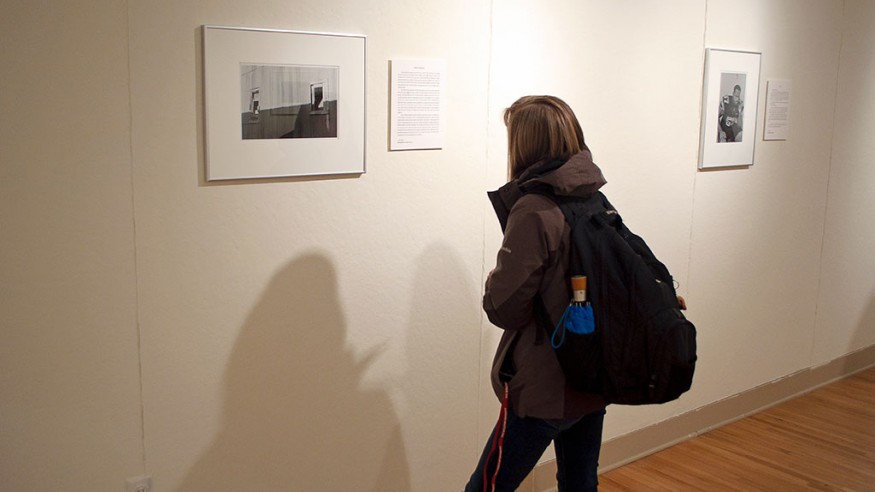
Expanding Horizons
Ohio Wesleyan students studying the ‘American Landscape’ created stories and photographs to help them see how the landscape can be represented in art. Their creations were displayed briefly on campus and now are being transformed into a virtual gallery that will be posted online. (Photo by Matt Wasserman ’14)
Ohio Wesleyan University professors Lynette Carpenter and Jeffrey Nilan believe a thorough understanding of the American Landscape is an essential part of a college education.
“We’re standing on it and living in it,” says Nilan, M.F.A., an associate professor of fine arts.
By participating in OWU’s American Landscape course connection, they have been able to put this belief into practice and share it with the campus community.
Their recent joint project, “A Thousand Words: Photographers and Writers Respond to the American Landscape,” exposed students to the cross-disciplinary components of a course connection program.
Ohio Wesleyan’s course connections “enable students to study a topic or problem from a variety of disciplinary perspectives, and to integrate those perspectives into a coherent and complex understanding of the topic. This multi-disciplinary approach unites courses that are already part of the OWU curriculum, supplementing them with lectures, activities, discussions and trips to bring the topic further into focus for both students and faculty,” according to the University.
Current course connections enable OWU students to study themes such as Crime, Responsibility and Punishment, as well as Poverty, Equity, and Social Justice. The American Landscape, one of six existing course connection networks, examines the American landscape in “reality and imagination,” including how the landscape is shaped by those who live on it and how it is represented through the arts.
Carpenter and Nilan began their project last fall to juxtapose American landscape literature and creative writing with photography to present a bold and broad view of the American landscape. Students from their photography and creative writing classes were paired up. The writers were given a photograph, and the photographers a story, to inspire their own creations.
“When students look at a landscape, or even the representation of a landscape, we want them to understand how much of what they ‘see’ is filtered through ideas about the American landscape,” Carpenter and Nilan explain.
The goals of the OWU educators included encouraging their students to take pride in seeing their work displayed professionally.
Senior Kayla Henderson participated in the project as a Photo Two student. She says the project was one of the most challenging she has completed, but the challenges were rewarding. The prospect of sharing her work with a broader community inspired her.
“The hardest part was trying not to take the story too literally,” Henderson says.
She wanted to illustrate the story she received with a certain sense of creativity. After several revisions and brainstorming sessions, Henderson realized that by using her own experiences and personal story, she could dig deeper and used this method to create her final product.
Senior Logan Osborne, a Photo Three student, used a similar process. Through multiple revisions of both his photo and the accompanying story, Osborne worked to relate to the writer without representing the story too literally.
Osborne says he learned a great deal and would recommend such courses to others.
Carpenter and Nilan are trying to make future courses a reality.
“The American Landscape faculty has been talking about ideas for different kinds of projects to do together and trying to imagine new ways to collaborate,” says Carpenter, Ph.D., a professor of English.
She says Ohio Wesleyan’s course connection networks encourage students to think across disciplines and to think synthetically about multiple disciplines. By expanding their horizons, she concludes, they are more likely to look for connections of their own.
Nilan agrees, adding that students who are interested in course connections tend to be more oriented toward the liberal arts – the essence of an Ohio Wesleyan education.
“A Thousand Words: Photographers and Writers Respond to the American Landscape” was displayed earlier this month in the Warner Gallery inside Edgar Hall. Currently, it is being transformed into a virtual gallery so that it can be made available online.
